Take a close look at this 22 days China tour from Hong Kong. In this tour, you will be accompanied to visit the most popular cities in China. From Hong Kong to Guilin, you can visit Victoria Peak, Stanley Market, Lantau Island and the Big Buddha in Hong Kong, appreciate Li River, Elephant Trunk Hill, Longji Rice Terrace Field and Reed Flute Cave in Guilin. You can enjoy beautiful natural scenery in Lijiang, such as Jade Dragon Snow Mountain, Spruce Meadow and Blue Moon Valley. China tour from Hong Kong with panda visit is broadly welcomed by tourists from home and abroad. You have an opportunity to observe cute pandas in closer distance. As a foodie, you will be regretful if you miss the delicious hot pot. Suzhou and Hangzhou are praised as paradises on earth, which must feast your eyes. Xi’an, the capital of 13 dynasties in ancient China, are full of historical and cultural atmosphere. And your tour will end in Beijing, the capital city of China. Start your new journey with us!

Welcome to Hong Kong! As a highly prosperous international metropolis, Hong Kong is the third largest financial center in the world, an important trade and shipping center, as well as an international innovation and technology center. Located in the south of China, Hong Kong covers Hong Kong Island, Kowloon, New Territories, and 262 surrounding islands, with a total land area of 1,106.66 square kilometers and a sea area of 1,648.69 square kilometers. With a total population of more than 7.47 million, Hong Kong is one of the most densely populated regions in the world. Hong Kong has a lot of attractions worthy of visiting, such as Victoria Peak, Aberdeen Fishing Village, Big Buddha, and Polin Monastery. You can not only see beautiful natural scenery but also enjoy various pleasures brought by the prosperous economy in Hong Kong. So please enjoy yourself here and discover the charm of Hong Kong.
Upon arrival, your local guide will pick you up according to your flight schedule at the airport and transfer you to your hotel. Then you could have a good rest and adjust yourself from jet lag. Your unforgettable 22-day China tour is approaching!
Today, we will arrange a half-day tour for you, and you can arrange the time in the afternoon by yourself. After breakfast, you will go to Victoria Peak, the place that provides a panoramic view of the Victoria Harbor. You can easily reach the summit by Peak Tram, which has been in service since 1888. During the ten-minute tram ride, you can see beautiful views out of the window. It is definitely a great experience! Upon arrival at the peak, you will come to the Peak Tower. Peak Tower, a seven-floor building, is a good place for recreation, shopping and sightseeing. You will find the Madame Tussaud’s here, featuring wax figures of celebrities and movie stars from all over the world, such as Bruce Lee, Jackie Chan, and David Beckham. If you are interested, you could consult your guide about buying tickets.
Then you will come to Aberdeen Fishing Village. Aberdeen Fishing Village, formerly known as Shek Pai Wan, is located in the west of the south bank of Hong Kong Island. You will take a sampan, a small boat, to visit the fishing village and experience the lifestyle of local fishermen in the most traditional manner. You could enjoy the splendid natural scenery and enjoy the cool breeze.
Next, we will head for Stanley Market. Located in the southeast of Hong Kong Island, Stanley Market is one of the well-known tourist attractions in Hong Kong. Stanley Market witnesses the combination of Chinese and Western culture. There are a number of Tang buildings (the special architectural style of Hong Kong, Macau, and parts of Southeast Asia during the period from the mid to late 19th century to the 1960s), which combine Chinese and Western architectural styles. Various shops selling jade ware, silk, antiques, watches, Chinese handiwork, and so on can be found in the market. You can buy your favorite souvenirs here for your families and friends. You can also enjoy the fun of bargaining here. If you are lucky, you could enjoy artworks created by talented local artists on Stanley Artsmart, held at Stanley Square on the second weekend of each month. After some free time here, you will be sent to your comfortable hotel to have a good rest.
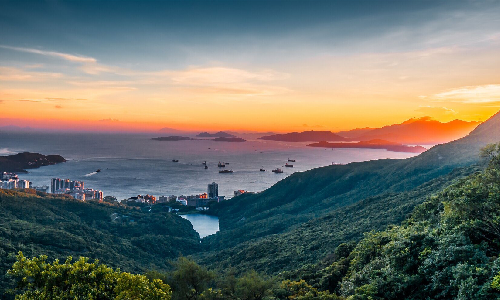
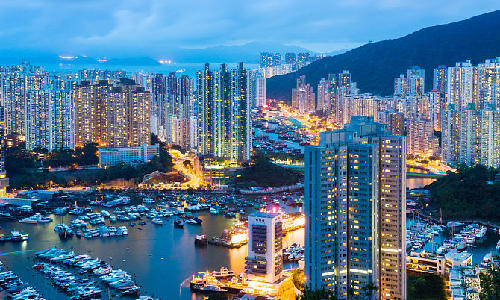
After breakfast, we will drive west for about 34 minutes to Tung Chung Cable Car Station on Lantau Island, which is about 32 kilometers away from the city center. Lantau Island covers an area of 147 square kilometers and is the largest island in Hong Kong. In the past, Lantau Island was undeveloped and thinly populated due to its remote location and the inconvenient transportation at the time. Later, with the completion of the Tsing Ma Bridge, Lantau Island is connected to downtown Hong Kong. Tung Chung Cable Car, also known as Ngong Ping 360 Cable Car, connects Tung Chung and Ngong Ping on Lantau Island. Ngong Ping 360 Cable Car ride is about 5.7 kilometers in length and it takes about 20 minutes to reach the top. During the 20-minute cable car ride, you will have a panoramic view of Lantau Island. There are two kinds of cable cars, standard cabin and crystal cabin. Usually, we will arrange the former for you. Both of the two types of cabins can accommodate about 8-10 people, with reserved space for wheelchairs. The difference between the two is that the crystal cabins have transparent floors, through which you can see lush mountains under your feet. It definitely will be an exciting experience. If you want to choose crystal cabins, please contact us.
Upon arrival at the top, you will first visit the Bronze Buddha. As an important landmark in Hong Kong, the Bronze Buddha is the tallest outdoor bronze seated Buddha in the world. Covering an area of 6,567 square meters, the 34-meter high Bronze Buddha is made up of 200 bronze castings. The face of the Bronze Buddha imitates the Locana Buddha in Longmen Grottoes (in Luoyang, Henan Province), while the patterns of its clothes imitate that of the Sakyamuni Buddha in the 360th cave in Mogao Grottoes (in Dunhuang, Gansu Province). What’s more, the lightning protection design of the Bronze Buddha is scientific and novel. The 325 hair knots on the head of the Buddha are designed to work as the lightning rods to protect itself from lightning.
Then you will head for your next stop, the Po Lin Monastery. Built in 1924, Po Lin Monastery has palace-style Main Shrine Hall of Buddha, Grand Hall of Ten Thousand Buddhas, and other halls. Grand Hall of Ten Thousand Buddhas has five floors. More that ten thousand golden Buddha statues of different sizes are placed on the first floor. Five giant golden Buddha statues are set up in the center of the hall. The hall is pretty big, and it can accommodate up to 100 Buddhists to worship Buddhas. The second floor is mainly used for expounding the texts of Buddhism and holding ceremonies. The third floor is used for meditation. A permanent altar is placed on the top floor used for the ceremony of imparting Buddhist disciplines. Walking into the hall, you may have a feeling that the quiet environment is gradually steadying your nerves, as if your soul has been purified. Polin Monastery is definitely a good place to lighten up for a while.
After lunch, you will have some free time at the Ngong Ping Village. Opened in June 2006, it covers an area of 1.34 hectares. Walking into Ngong Ping Village, you will see various shops, entertainment facilitates, as well as restaurants where you can enjoy authentic local snacks and delicious delicacies. As an exquisite Chinese-style architecture, Ngong Ping Teahouse is a good place to enjoy Chinese tea and fine desserts. If you are lucky, you might see wonderful street performances in the village, such as Kungfu, juggling and Cantonese Opera. You can stroll around and take photos of interesting places. This is the end of your Hong Kong tour today, and then we will send you to your comfortable hotel for a good rest.
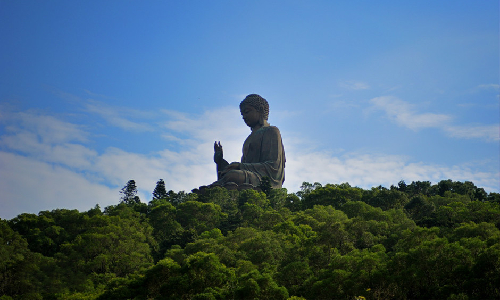
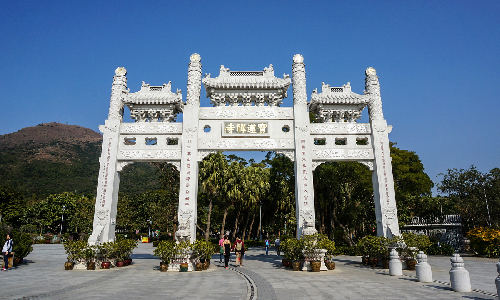
 Guilin
Guilin After breakfast, you will be transferred to Hong Kong West Kowloon Railway Station and take the estimated high speed train G408 12:05/15:25 to Guilin. Located in the northeast of Guangxi Province, Guilin has long been a travel destination for tourists from home and abroad. Covering a total area of 27,800 square kilometers, it has a population of more than 4.93 million. Due to its abundant rainfall and mild climate, Guilin is rich in forest resources, and the forest coverage rate is up to 70.91%. Guilin boasts splendid natural scenery, such as Li River, Elephant Trunk Hill, Longji Rice Terrace Field, and Reed Flute Cave. In a word, Guilin is a nice place to feast your eyes and enjoy yourself. Upon arrival, your local guide will be waiting for you in the train station and then send you to your comfortable hotel to have a good rest.
After breakfast, you will go to Elephant Trunk Hill for sightseeing. Occupying an area of 118,800 square meters, Elephant Trunk Hill is a natural tourist attraction with karst landform. Located at the confluence of the Taohua River and the Li River, Elephant Trunk Hill is named for its resemblance to a giant elephant standing by the river with its nose stretching out and drinking water from Li River. It is a nice place to take pictures to post on your social media! Then, we will drive northwest for about two hours to visit Longji Rice Terrace Field, around 80 kilometers away from Elephant Trunk Hill.
Longji Rice Terrace Field refers to terrace fields developed on the Longji Mountain. Longji Rice Terrace Field is located at an altitude between 300 meters and 1,100 meters. The road to Longji Rice Terrace Field is with a lot of twist and turns. If you are the type that easily gets carsick, make sure you bring some pills for carsickness with you. The Longji Rice Terrace Field boasts spectacular scenes, thus it is a good place to photograph. Best shooting periods are from late May to mid-June, mid-July, and during Mid-Autumn Festival. If you are fond of photography, you shouldn’t miss the opportunity. After visiting, we will go back to downtown and then you will be transferred to your comfortable hotel.
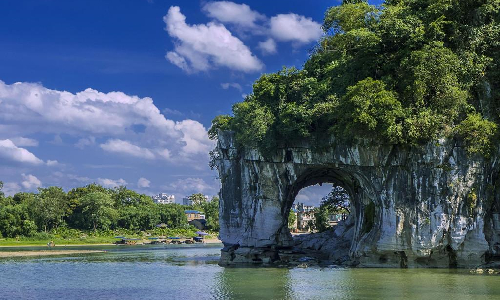
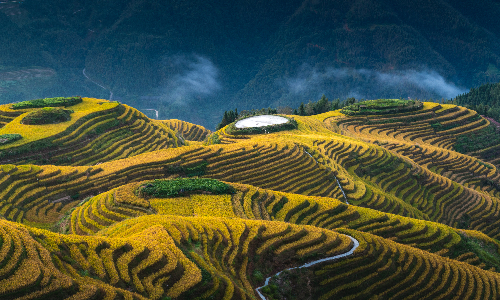
 Yangshuo
Yangshuo In the morning, your guide will take you to Maoping Port that is located in the southeast of Guilin. It is about 35 kilometers away from the city center and the drive will take about 1 hour and 10 minutes. You will board your cruise ship at the port. Then you will take the Li River Cruise for about 4 hours to go to Yangshuo. During the cruise, you can enjoy beautiful scenery on both sides of the Li River. As for the cruise tour, we will provide two kinds of plans. One is three-star cruise tour, including Chinese boxed lunch at lunchtime. The other is four-star cruise tour, including Chinese buffet at lunchtime. Besides the difference on lunch, the facilities, decorations as well as price of the three and four-star cruise ships are different. If without prior notice, we will arrange the three-star cruise tour for you for being cost effective.
In the afternoon, when the Li River Cruise is over, you will head for Yangshuo West Street. Yangshuo West Street is a pedestrian street. Located in the center of Yangshuo Ancient Town, Yangshuo West Street is about 8 meters wide and nearly 800 meters long. With a history of more than 1,400 years, it is the oldest and most prosperous street in Yangshuo. Yangshuo West Street is also called the Foreigners’ Street, because a lot of foreigners gather here. Almost everyone here can speak some English, so Yangshuo West Street is a very popular place for foreign tourists. In 1998, according to statistics, more than 1,000 foreigners visited here everyday. There are more than 20 shops set up by foreigners. Walking into the street, you may feel a bustling and exotic atmosphere. After some free time here, you will be sent to your comfortable hotel in Yangshuo to have a good rest.
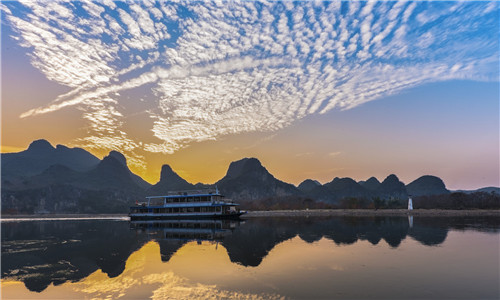
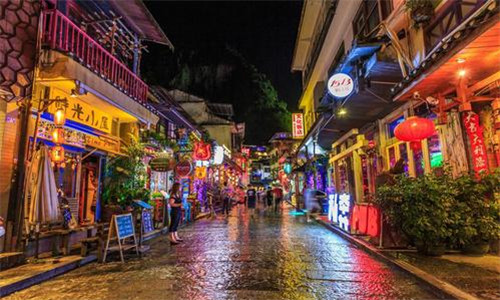
 Guilin
Guilin Kunming
Kunming In the morning, we will drive northwest for around one hour and twenty minutes to Guilin, which is about 66 kilometers away from Yangshuo West Street.
Upon arrival in Guilin, you will go to Reed Flute Cave. It is said that there was a kind of reed growing at the mouth of this cave. This kind of reed could be made into flutes that played a pleasant sound, thus Reed Flute Cave got its name. Reed Flute Cave is 240 meters deep and 500 meters long. Entering the cave, you can enjoy beautiful and exquisite stalagmites, stalactites, and stone flowers in different shapes, all of which are formed by the effect of underground water dissolving the calcium carbonate in the rock, and through precipitation, accumulation as well as crystallization for more than one million years. No wonder that Reed Flute Cave is praised as a natural palace of art. Colorful lights set Reed Flute Cave off to a wonderland. You should seize the opportunity to feast your eyes!
Then we will send you to the railway station and you will take the estimated high speed train G2936 17:07/21:44 to Kunming. Kunming, the provincial capital of Yunnan Province, is a beautiful city with lots of natural attractions. Covering a total area of about 21,012 square kilometers, it now has a population of more than 8.46 million. Kunming has spring-like four seasons, known as “spring city”. Due to its warm climate and natural landscape, Kunming is one of the most popular cities in China. As a multiethnic city, its unique folk customs attract more and more tourists from home and abroad. Kunming is a city where you will be enchanted by its natural scenery and do not want to leave anymore. Upon arrival, your local guide will be waiting for you and then send you to your comfortable hotel in Kunming to have a good rest.
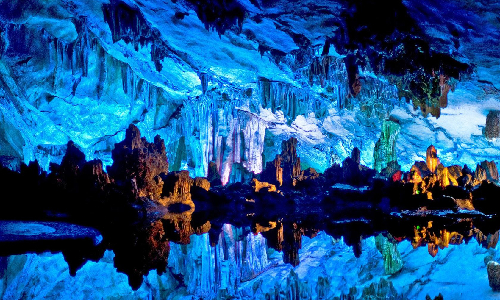
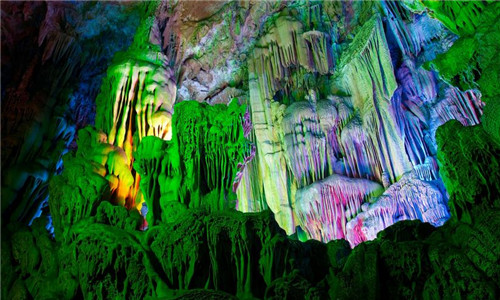
 Lijiang
Lijiang After breakfast, we will drive southeast for about an hour and twenty minutes to visit Stone Forest, 85 kilometers away from Kunming. About 300 million years ago, Stone Forest was a vast expanse of water. After a long geological evolution, extremely precious geological relics were formed. Stone Forest is the only karst landform in the subtropical plateau in the world. It has been rated as World Geopark and World Natural Heritage Scenery by UNESCO. Stone Forest boasts natural attractions, such as Naigu Stone Forest, Ashima, Breathing Cave, Stone Folding Screen and Long Lake. As for Long Lake, it is 5,000 meters in circumference, 300 meters in width, and 24 meters in depth. It is said that the shape of the lake is like a slender girl. Long Lake is surrounded by mountains, which are at altitudes of 1,907 meters or so. The water, derived from underground water, is very clear. Long Lake is hidden in a place where few people can discover, so it is also called Hidden Lake.
In the afternoon, you will come to Green Lake Park. Green Lake Park is a good place to take a walk at leisure. In the early 20th century, lots of weeping willows and a variety of lotuses were planted in the park. The green lake as well as the weeping willows make the park seem like an emerald in Kunming, thus Green Lake Park wins a reputation as “the jade of the city”. It is worth mentioning that tens of thousands of black-headed gulls fly to Kunming from Siberia every winter, some of which roost in the Green Lake Park. Every November, the locals will warmly welcome the black-headed gulls. At this time of the year, it will be a great pleasure for local people as well as many tourists to feed the gulls. And in every summer, grand lotus festival will be held here. If you are lucky, you could enjoy more than twenty varieties of lotuses, which must be a pleasant experience.
Then you will be transferred to the railway station and take the estimated high speed train D8788 17:22/20:32 to Lijiang. Lijiang is a national historical and cultural city. Covering a total area of around 20,000 square kilometers, it has a population of more than 1.25 million. As a multiethnic city, Lijiang is populated by 22 ethnic minorities. It is a popular city for tourists from home and abroad to experience various folk customs. There are several attractions worthy of visiting, such as Jade Dragon Snow Mountain, Shuhe Ancient Town and Lijiang Ancient Town. Getting off the high speed train, you will be warmly welcomed by your local guide and then transferred to your comfortable hotel in Lijiang.
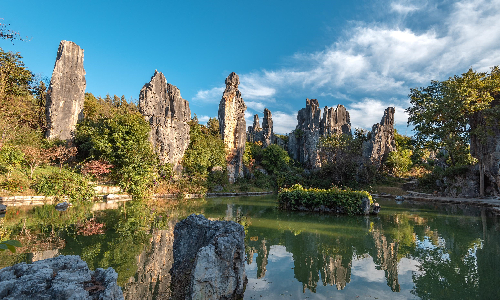
In the morning, you will arrive at the foot of Jade Dragon Snow Mountain. Stretching a length of 75 kilometers, Jade Dragon Snow Mountain is a mountain covered by snow all year round. It is the southernmost glacier area in Eurasia. According to the Glacier Inventory published in 1994, Jade Dragon Snow Mountain has 19 glaciers, covering an area of 11.6 square kilometers. A ski resort, located in the eastern slope of Shanzi Peak, the main peak of Jade Dragon Snow Mountain, has snow in all seasons, which is a perfect attraction for enthusiastic skiers.
Then you will go to Spruce Meadow by cable car. Spruce Meadow, located in the east of Jade Dragon Snow Mountain, is a large meadow that hides in the primeval spruce forest. It is at an altitude of 3,240 meters. Spruce Meadow means a land of tragic love according to the language of Naxi nationality. It is said that Spruce Meadow is a place where the first couple of Naxi nationality died for love. The man decided to marry the woman, and only her. But they were persecuted by those who were in favor of polygynous marriages. The couple finally decided to commit suicide at the Spruce Meadow to show their loyalty to each other. On Torch Festivals, young men and women who settle in the villages near Jade Dragon Mountain will come to Spruce Meadow to pay homage to the tragic couple. Strolling around, you will see some girls dressed in bright ethnic costumes singing and dancing in the meadow, adding unique charm to this green grassland decorated with colorful flowers.
Then we will return to the foot of the mountain and drive southeast for about 12 minutes to visit Blue Moon Valley, 7 kilometers away from Spruce Meadow. Blue Moon Valley is famous for its lofty and magnificent snow-covered mountains, beautiful valleys, and extremely blue lake. Blue Moon Valley gets its name from the blue lake and crescent-shaped valley, which is said to be the prototype of the Blue Moon Valley in The Lost Horizon written by British writer James Hilton. On sunny days, the color of the lake is blue. On rainy days, the color of the lake is white because of the white mud in the lake, thus Blue Moon Valley is also called White Water Lake. Isn’t it interesting? Blue Moon Valley is a wonderful place for photography enthusiasts.
In the afternoon, you will go to Baisha Village. Baisha Village, at the foot of Jade Dragon Snow Mountain, has a history of more than 1,000 years. It was once the political, economic, and cultural center of Lijiang. There are currently about 55 Baisha mural paintings preserved here. These mural paintings are the representatives of Lijiang murals, painted in the Ming Dynasty (1368-1644) and Qing (1636-1912) Dynasty. Baisha mural paintings have absorbed the refined brushwork of paintings of Han nationality, and combined with the smooth style of Tibetan Buddhism paintings. Nowadays Baisha mural paintings have become a treasure of mural arts in China.
Then we will drive southward for about 10 minutes to visit Shuhe Ancient Town, 5 kilometers away from Baisha Village. Shuhe Ancient Town is one of the earliest settlements of the ancestors of Naxi nationality in Lijiang. Entering the town, you may see a bridge called Tsing Lung Bridge spanning a river. Built in the Ming Dynasty, Tsing Lung Bridge has a history of more than 400 years and is one of the oldest stone bridges in Lijiang. It has a length of 25 meters, a width of 4.5 meters and a height of 4 meters. Although the surface of the Tsing Lung Bridge has become mottled after going through hundreds of years of wind and rain, it is still completely steady. Standing on the bridge, you can enjoy charming ancient buildings and bustling street scenes along the river.
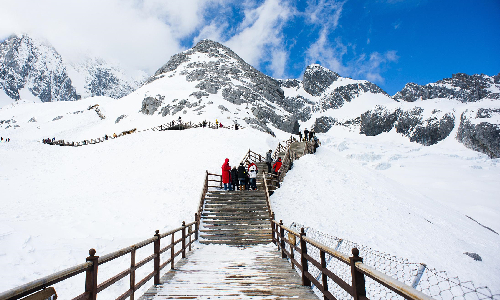
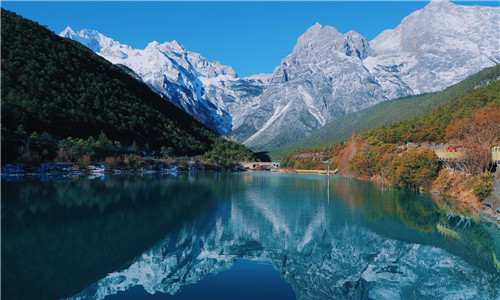
 Chengdu
Chengdu After breakfast, you will go to Lijiang Ancient Town for sightseeing. Built in the late 13th century, Lijiang Ancient Town covers an area of 7.279 square kilometers. It is a well-known historical and cultural town, where you can experience the lifestyle of Naxi nationality. The streets of Lijiang Ancient Town are paved with red breccia, and are built along rivers. Having lots of bridges is the most prominent characteristic of the town. Sifang Street is a snack street in the ancient town. There are dozens of restaurants on both sides of the street. Almost every restaurant has various kinds of Rice Noodles, a famous traditional local dish in Yunnan, so the street is also called Rice Noodles Street. The Sifang Street Square here was once the most important hub on the Ancient Tea Horse Route, a commercial route in southwest China in ancient times. Since Ming and Qing Dynasties, merchants from many places gathered here for business. Sifang Street Square is also an important place for local residents to celebrate festivals and activities. At festivals, a stage will be set up on the north of the square and people dressed in their ethnic costumes will sing and dance happily.
In the afternoon, you will be transferred to the airport and take the estimated flight TV9892 17:25/18:45 to Chengdu. Chengdu, the provincial capital of Sichuan Province, is located in southwest China. Covering a total area of 14,335 square kilometers, it has a population of more than 20.93 million. As a city with a long history, Chengdu boasts famous attractions, such as People’s Park, Wuhou Temple and Jinli Street. In particular, pandas and hotpot have attracted a lot of tourists. Wish you have fun in Chengdu! Upon arrival, your local guide will wait for you at the airport, holding your name sign, and then transfer you to your comfortable hotel in Chengdu for a good rest.
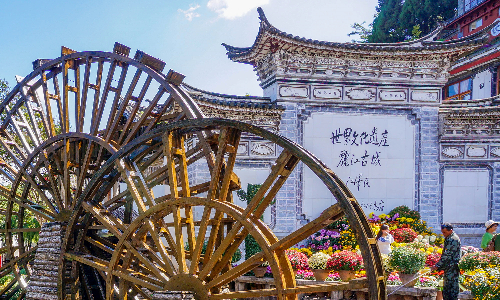
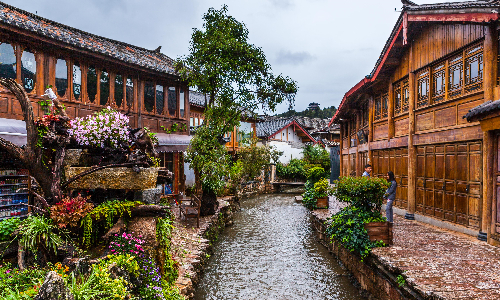
After breakfast, you will head for Chengdu Research Base of Giant Panda Breeding to visit lovely pandas. It is a well-known conservation and research institute for rare and endangered wild animals in China and even the world. Built in 1987, Chengdu Research Base of Giant Panda Breeding is the world’s largest breeding and research place of giant pandas, covering an area of around 67 hectares. It was built on a mountain, combining wilderness area, and artificial landscape. Walking into the base, you can see cute pandas eating bamboos at leisure. Do you know that currently there are fewer than 2,000 giant pandas in the world? Three million years ago, a large number of giant pandas had ample food. Later, the earth experienced the Ice Age and the climate became colder and colder. Many animals died out because they could not adapt to climate change. Only a few pandas hiding in the mountains and valleys survived. Besides, they have a low reproductive rate, so giant pandas are rare in the world.
In the afternoon, you will go for a stroll in People’s Park. Built in 1911, People’s Park is a comprehensive park integrating culture and recreation. Walking into the park, you can see the slow-paced lifestyle of locals. Heming Tea House is a good place to have tea. With a history of nearly 100 years, it is one of the oldest traditional teahouses in Chengdu. Sitting on a bamboo-made chair, you could hear stories and anecdotes about Chengdu—given that you can speak some Chinese. What’s more, you can even learn some Chengdu dialect with the locals.
Then you will go to your next stop, Wuhou Temple. First built in the year of 221, Wuhou Temple occupies an area of 150,000 square meters. It was originally a temple to commemorate Zhuge Liang, a militarist in the Three Kingdoms period (220-280) in ancient China. Later on, it became a temple worshipping Zhuge Liang and Liu Bei, the first emperor of the Shu Kingdom(221-263) in the Three Kingdoms period. Walking into the Temple of Zhuge Liang, you can see three statues. The one in the middle is Zhuge Liang, and his son, as well as his grandson, stand on each side of him. Zhuge Liang holds a feather fan in his hand and wears a scarf of black silk ribbon as well as a cloak, looking elegant.
After that, you will go to your last stop in Chengdu, Jinli Street. Covering an area of more than 30,000 square meters, Jinli Street is about 550 meters long. It is said that the street was one of the oldest and most commercialized streets in ancient China, which was famous throughout the country as early as in the Qin Dynasty (221 BC-207 BC). Now the street integrates shopping and recreational activities. Jinli Street is the place where you will see folk music performances, dramas, folk costume shows, and other folk performances. This is also the place that special theme activities according to Chinese traditional festivals are held.
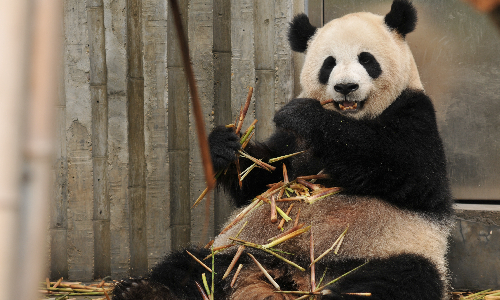
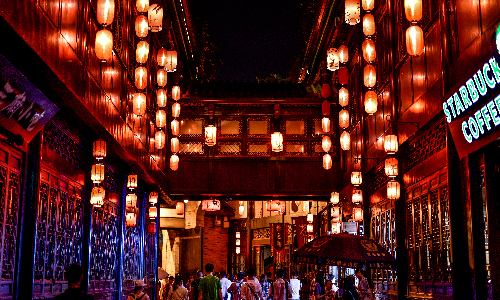
 Shanghai
Shanghai You have the whole morning to yourself. You can either have a good rest in the hotel or stroll around in the vicinity.
In the afternoon, you will be sent to the airport and take the estimated flight MU5418 16:00/19:00 to Shanghai. Shanghai is an international metropolis located in southeast China. Covering a total area of 6340.5 square kilometers, it has a population of more than 24 million. Shanghai is an inclusive city that boasts traditional and modern attractions, such as Jade Buddha Temple, Yu Garden, Shanghai Old Street, Shanghai Tower, and the Bund. In the next few days, you will fully feel the unique charm of this city. Upon arrival, your local guide will pick you up at the airport and then transfer you to your comfortable hotel in Shanghai. Wish you have an unforgettable journey!
After breakfast, you will visit Jade Buddha Temple. Although located in the bustling downtown, Jade Buddha Temple is a good place for seeking tranquility and slow-paced life, so it is often likened to a pure land in the downtown. Jade Buddha Temple is named after the Jade Buddhas worshipped in the temple. Built in the year 1900, it is an imitation of temples of the Song Dynasty (960-1279). There are more than 200 halls and rooms besides the three main halls along the medial axis. And there’s an interesting bell in the temple. It is said that if you truly believe in Buddhism, you can make a clear and crisp sound when you strike it. And for those who are not that devoted, no matter how hard they strike the bell, it won’t make a clear sound. Many tourists would have a try out of curiosity. Walking into the temple, you could stroll around and indulge yourself in the quiet environment.
Then you will go to Yu Garden (closed each Monday) for sightseeing. With a history of more than 400 years, Yu Garden was a private garden in the Ming Dynasty. It was built by Pan Yunduan, an officer of Sichuan Province, for his parents to live after their retirement. The construction lasted for more than 20 years. In Chinese culture, Yu means peace and health. Pan Yunduan built the garden and named it Yu Garden hoping that his parents can spend a tranquil retired time there. Walking through the Huanlong Bridge, you can see Exquisite Jade Rock. It is not jade, but a type of rock, which is eroded by water. The most prominent feature of the rock is that it has many holes, and looks like a honeycomb. If you pour water from the top, the water will come out from its 72 holes. If you burn incense below the rock, misty smoke will flutter from those holes. After spending some time observing the Exquisite Jade Rock, you can go for a stroll to enjoy other interesting places in the garden.
Afterward, you will come to Shanghai Old Street. With a length of more than 800 meters, it has completely restored the architectural style and characteristics of the folk houses in the Ming and Qing Dynasties. Shops with traditional characteristics dot on both sides of the street. Time-honored places such as teahouses, restaurants, and gold shops can be seen everywhere. You can stroll around in the vicinity and taste delicious traditional snacks.
In the afternoon, you will visit Shanghai Tower. Occupying an area of 30,368 square meters, Shanghai Tower is one of the landmark buildings of Shanghai. With a total height of 632 meters, the main body of the building has 127 floors above the ground and 5 floors underground. As a comprehensive building, it combines offices, entertainments, exhibition areas, conference halls, and so on. The viewing platform is on the 118th floor and the lift will take you to the platform at a speed of 18 meters per second. Standing on the viewing platform named Top of Shanghai, you can have a panoramic view of the whole city, and in the meantime, take some nice pictures. This place will make a nice post on your Instagram.
Then you will go to the Bund. As one of the landmarks of Shanghai, 52 classical revival buildings of various styles, known as Exotic Building Cluster stand here, attracting more and more tourists from home and abroad to experience the diversified culture.
After that, you will come to Nanjing Road. Nanjing Road is the earliest commercial street after the opening of the port in Shanghai. Stretching 5.5 kilometers, it is generally divided into two commercial areas, East Nanjing Road and West Nanjing Road. The former is a street that mainly sells something less expensive, while the latter is the most luxurious and fashionable commercial area in Shanghai with the highest rental fee in China. Nanjing Road is a place where lots of merchants gather for business, as well as a paradise for tourists from home and abroad to go shopping. After having fun in Nanjing Road, today’s trip is going to end now. You will be transferred to your comfortable hotel for a good rest.
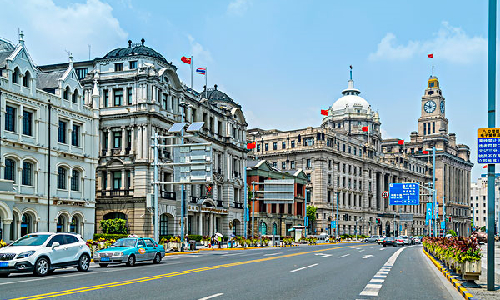
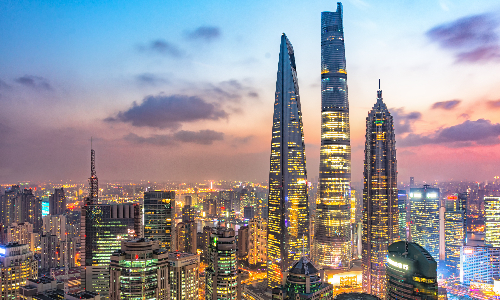
After breakfast, we will drive southwest for around 53 minutes to visit Zhujiajiao Ancient Water Town, about 48 kilometers away from the city center. Covering a total area of 136.85 square kilometers, Zhujiajiao Ancient Water Town is praised as one of the four famous historical and cultural towns in Shanghai. Fangsheng Bridge is an important part of this fascinating town. Legend has it that a fisherman caught a golden fish who was actually the little daughter of the Dragon King of the East Sea, the god of rain in Chinese mythology. Bodhisattva, a divine being that always helps men to salvation, came across the fisherman and recognized the daughter of the Dragon King. So Bodhisattva told this fisherman to release the fish. He agreed and later became an arhat enlightened by Bodhisattva. Moved by this story, later generations built the bridge and named it Fangsheng Bridge (Fangsheng means release lives in Chinese). On every first day of the lunar calendar, local monks will hold a grand ceremony on the bridge to release fish into the river below as a sign of respect for life.
In the afternoon, you will go to the Former French Concession. This one is the earliest, largest, and most prosperous one among the four French Concessions in China. There is a very quiet road called Wukang Road, with a length of about 1 kilometer. Lush platanus are planted on both sides of the road. Here in the past has been the most typical high-end residential area in Shanghai French Concession. Buildings with English, French, Spanish and Mediterranean styles stand here, making it one of the European-style roads in Shanghai. Numerous celebrities, like Sun Yat-sen, a leader of the Revolution of 1911, have lived here. Walking on Wukang Road, you can enjoy various courtyards and buildings that have witnessed the development of Shanghai.
Then you will come to your last stop in Shanghai, Tianzifang Market. There are creative shops, galleries, photo exhibitions, and coffee shops in the market, presenting a strong atmosphere of culture and art. If you look carefully, you can even find the green letterbox decorated with the logo in the 1980s, which presents an unexpected artistic beauty. Antique shops also attract numerous collectors of antiques from home and abroad. You can stroll around in the vicinity and enjoy a slow-paced afternoon.
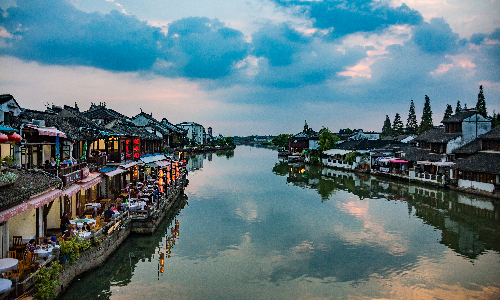
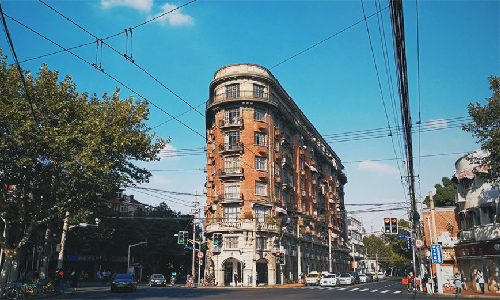
 Suzhou
Suzhou After breakfast, we will drive westward for one and a half hours to go to Suzhou, around 100 kilometers away from Shanghai. Suzhou, known as a paradise on earth, is a famous scenic, historical and cultural city in China. It occupies a total area of 8,657.32 square kilometers and has a population of more than 12.74 million. Suzhou boasts numerous tourist attractions, such as Lingering Garden, Humble Administrator’s Garden, Shantang Street, and Tiger Hill. Upon arrival, you will first visit the Lingering Garden. Built in the Ming Dynasty, the Lingering Garden is a classical garden of Suzhou, as well as one of the four famous gardens in China. Covering an area of 23,300 square meters, it can be divided into four parts. You can enjoy charming ancient buildings in the east part, lakes, and gardens in the central part, artificial hills in the west part, and pastoral scenery in the north part. People in Suzhou have a tradition of appreciating orchids. Since the late Qing Dynasty, they have held orchid exhibitions every spring, mostly in the Lingering Garden. If lucky, you could enjoy orchids with different varieties and listen to stories as well as poems about the flowers.
In the afternoon, you will go to Shantang Street. Shantang Street is named after Shantang River. In 825, a well-known poet called Bai Juyi was appointed as a governor in Suzhou. He dredged the northwest watercourse outside Suzhou and dug the Shantang River, so the ancient street built along the river was called Shantang Street. You can enjoy traditional Jiangnan (regions south of the Yangtze River) style houses here. It is a good place to take photos.
Then you will come to Tiger Hill. With a history of more than 2,500 years, Tiger Hill is 34.3 meters above sea level and covers an area of 0.19 square kilometers. The hill is made up of Jurassic volcanic magma. According to Records of the Historian, an emperor named He Lv died in a war and was buried here. It is said that a white tiger squatted on his tomb for three days, so Tiger Hill got its name. There is a pagoda called Tiger Hill Pagoda, which is known as the Leaning Tower of Pisa in China. The pagoda slopes northeast, with its top 2.34 meters off-center. Having witnessed the 2,500-year history of Suzhou, Tiger Hill is worth a visit.
Suzhou No.1 Silk Factory is your last stop in Suzhou. Founded in 1926, Suzhou No.1 Silk Factory is a century-old factory with profound culture. Through silk production shows, silk culture shows and so on, tourists can fully understand the process of making silk. In order to enhance the aesthetic values of silk, people often embroider animal or flower patterns on the silk pieces, through which embroidery comes into being. Suzhou embroidery, one of the four famous embroideries in China, has formed a local style of beautiful patterns, harmonious colors, and skillful needlework.
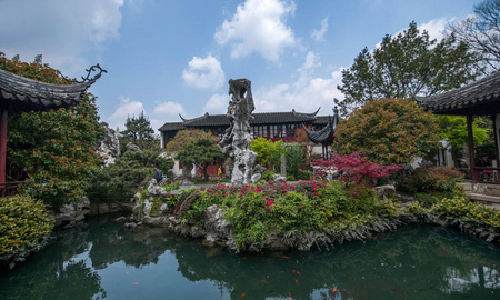
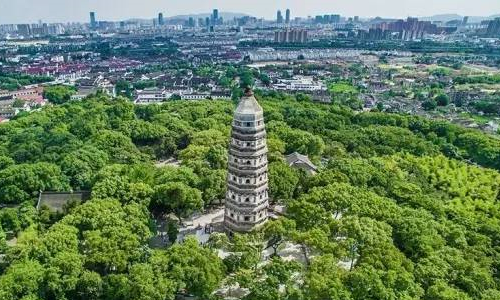
 Hangzhou
Hangzhou In the morning, you will be transferred to the train station and then take the estimated high-speed train G7507 09:36/11:06 to Hangzhou. Hangzhou, the provincial capital of Zhejiang Province, covers a total area of 16,850 square kilometers, it has a population of more than 11.93 million. Hangzhou boasts numerous well-known attractions, such as West Lake, Lingyin Temple, and Six Harmonies Pagoda. Upon arrival, you will be warmly welcomed by your local guide and then transferred to your hotel.
After lunch, you will visit Meijiawu Tea Plantation. Occupying an area of more than 1.53 million square meters, Meijiawu Tea Plantation has a history of over 600 years. In the 1950s and 1960s, it was already a sightseeing area open to guests. Over the decades, it has received numerous tourists and hundreds of international leaders. West Lake Dragon Well Tea, one of the top ten famous teas in China, is mainly produced around the West Lake. The tea is green in color, rich in aroma, and refreshing in taste. It has already been famous at home and abroad. And it is selected as a national tea served for state guests.
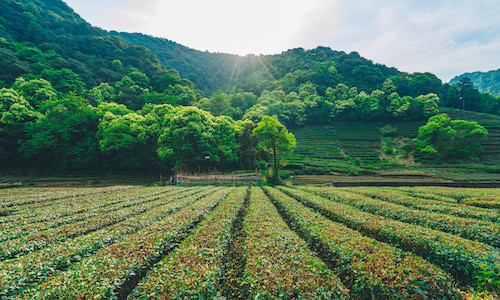
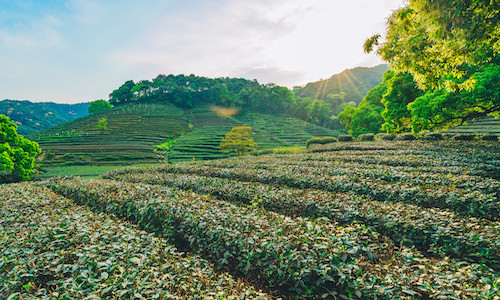
In the morning, you will take the West Lake boat to enjoy beautiful scenery of West Lake. Covering an area of 49 square kilometers, West Lake has more than 100 sights. Sitting in the boat, you can see Broken Bridge quietly straddling banks, Leifeng Pagoda standing high in a distance, and lush trees along the banks. Watching beautiful reflections of clouds and weeping willows as well as feeling the cool breeze will make you feel at ease.
Getting off the boat, you will go to Lingyin Temple. Lingyin Temple is an ancient Chinese Buddhist temple. Built in the year 326, it covers an area of 87,000 square meters. When we talk about Lingyin Temple, the Feilai Peak (means a flying peak in Chinese) in this scenic area must be mentioned. Legend has it that this flying peak used to fly here and there, crushing houses into pieces. And there was a monk living in Lingyin Temple that was very talented but a bit peculiar. One day, the monk predicted that the flying peak was coming toward the village nearby Lingyin Temple. He went to the village and tried to warn the residents about this, but no one believed him. So he had to “steal” a bride from a wedding that was going on in the village. The villagers were so angry and chased after him. The monk didn’t stop running until reaching a place far enough from the village. Just when the villagers were going to swear at him, the peak crashed into the village. The villagers finally understood what the monk had done and thanked him. The monk then proposed to add more rocks on top of the peak, so that it cannot fly. The villagers did as he said, and it is the Feilai Peak you see today.
In the afternoon, you will go to Leifeng Pagoda. Built in 977, Leifeng Pagoda is the first colorful bronze pagoda in China. With a total height of 71.679 meters, it occupies an area of 6,089 square meters. As for the Leifeng Pagoda, there are several legends about it. One of them goes like this: A lady named Bai Suzhen is a snake spirit who has been practicing magic for thousands of years. In order to repay a mortal named Xu Xian for once saving her life, she changes into a mortal and helps him in every way she can. Later, they fall in love and get married. After their marriage, a monk called Fa Hai tells Xu Xian that his wife is a snake spirit. At first, Xu Xian didn’t believe him, but Fa Hai persuades that he should listen to him and test Bai Suzhen. Doubtfully, Xu Xian follows Fa Hai’s plan, and cajoles his wife into drinking realgar wine (has the effect of making spirits show their true forms) on the Dragon Boat Festival. As a result, she changes into a snake, which almost frightens Xu Xian to death. Then Fa Hai tricks Xu Xian into Jinshan Temple and puts him under house arrest. Worried about her husband, Bai Suzhen fights against Fa Hai with magic and floods Jinshan Temple. Because of hurting innocent people, she is punished and locked inside the Leifeng Pagoda after giving birth to her baby. As time goes by, her son grows up and manages to rescue her. Finally, she is reunited with her family.
Then you will go to your last stop in Hangzhou, Six Harmonies Pagoda. Built in the Song Dynasty (960-1279), Six Harmonies Pagoda covers an area of 890 square meters. With a height of 59.89 meters, it has 13 floors, with 104 iron bells hanging on the eaves of every floor outside the pagoda. After visiting this pagoda, your guide will take you back to your hotel.
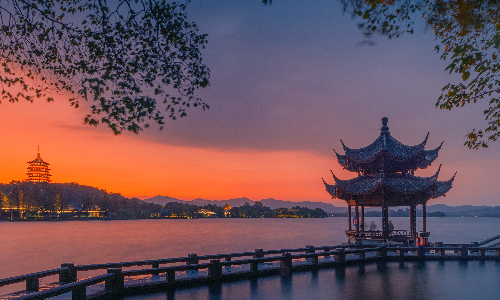
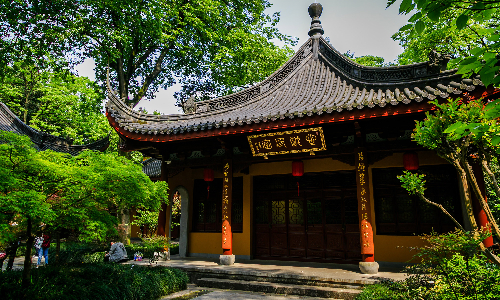
 Xi’an
Xi’an It’s time to say goodbye to Hangzhou. After breakfast, you will be transferred to the airport and take the estimated flight HU7862 11:45/14:15 to your next destination Xi’an. Xi’an, the provincial capital of Shaanxi Province, is one of the best places to travel in China. Covering a total area of 10,108 square kilometers, it has a population of more than 12.95 million. Being the capital city in 13 dynasties, Xi’an is a city full of historical and cultural atmosphere. In Xi’an, there are a great number of tourist attractions, such as Terra Cotta Warriors and Horses Museum, Big Wild Goose Pagoda, the Great Mosque, and Muslim Street. You can also taste delicious traditional snacks here, like Rougamo (a kind of Chinese hamburger) and Pita Bread Soaked in Lamb Soup. Xi’an is definitely worth a visit! Upon arrival, your local guide will be waiting for you at the airport and then transfer you to your comfortable hotel in Xi’an.
After breakfast, we will drive northeast for about 45 minutes to visit Terra Cotta Warriors and Horses Museum, 40 kilometers away from the city center. Terra cotta warriors and horses are sacrificial objects of Qin Shihuang, the first emperor of the Qin Dynasty (221BC-207BC). It is speculated that countless treasures and sacrificial objects had accompanied the emperor after his death. Looking carefully, you may find that the terra cotta warriors and horses are life-sized. They vary in height, uniform, and hairstyle in accordance with ranks. All of them were made with superb skills, giving you an illusion that they will revive overnight. Terra cotta warriors and horses were collectively praised as the Eighth Wonder of the World and included in the World Heritage List by UNESCO in 1987.
In the afternoon, you will go to Big Wild Goose Pagoda for sightseeing. Built in the year 652, Big Wild Goose Pagoda preserved Buddhist scriptures and statues of Buddha brought by a pious monk called Xuanzang in the Tang Dynasty (618-907). Legend has it that Xuanzang lost his way in a desert during his pilgrimage to the west. Just when he was running out of water, a wild goose flew over the desert. After a respectful salute to the goose, Xuanzang said, “I am going to the west to seek Buddhist scriptures, but I lost my way. If you can lead me out of the desert, I will thank you by building a pagoda once returning to Chang’an (the ancient name of Xi’an).” The wild goose nodded in agreement and then led him out of the desert. After returning to Chang’an, Xuanzang kept his promise and built the Big Wild Goose Pagoda.
Then you will come to the Great Mosque. Built in the Tang Dynasty, the Great Mosque is the largest mosque in Xi’an, with a history of more than 1,200 years. In the early Tang Dynasty, ancient China began to trade with Arab countries. Owing to the Silk Road (a route over which silk and other products were transported to Southwest Asia and Europe), Arab merchants entered Chang’an, as well as Islam. As a symbol of Islamic culture, the Great Mosque was built in Chang’an. The Great Mosque not only has the characteristics of Islamic culture, but also integrates the styles of traditional Chinese architecture. It is a result of the integration of Islamic culture and traditional Chinese culture. Nowadays it is still an important place for Islamic activities in Xi’an.
Muslim Street is your last stop in Xi’an. Muslim Street stretches about 500 meters. With most shops and snack stands run by Muslims, the street gets its name. This bustling street is well-known for the delicious snacks. You can taste delicious traditional snacks here, like Rougamo (a kind of Chinese hamburger) and Pita Bread Soaked in Lamb Soup. Strolling around the street, you can see exquisite antiques and buy handicrafts you like.
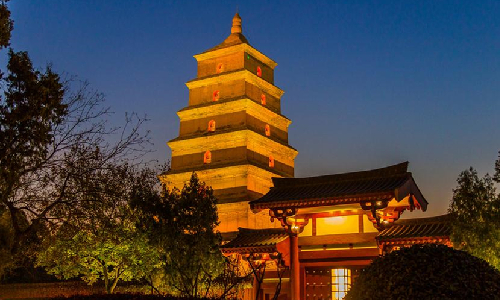
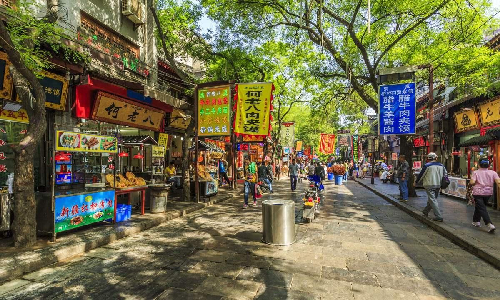
 Beijing
Beijing In the morning, you will be transferred to the railway station and take the estimated high-speed train G350 10:22/14:46 to Beijing. As the capital of China, Beijing is one of the most popular cities for tourists around the world. It is a prosperous international metropolis as well as China’s political and cultural centers. Covering a total area of about 16,410 square kilometers, Beijing now has a population of more than 21.89 million. As an ancient capital with a history of over 3,000 years, Beijing boasts rich cultural heritage sites, such as the Summer Palace, the Forbidden City, and the Great Wall.
In the afternoon, your local guide will pick you up at the train station and then transfer you to your first stop in Beijing, the Summer Palace. The Summer Palace, formerly known as the Qingyi Garden, is the largest and best-preserved imperial garden in China. In 1750, emperor Qianlong in the Qing Dynasty spent a lot of money on building the garden to honor his mother. Covering an area of about 3 square kilometers, the Summer Palace is the place where the royal families used to stay while traveling in summer. Walking along the Kunming Lake, you could see a Marble Boat standing in the northwest of the lake. With 36 meters in length, its body is carved out of huge stones. As an old Chinese saying goes, the water can carry a boat and can also overturn it. It indicates that people can give their full support to an emperor and they also can overthrow him if he ignores public opinions. So the Marble Boat is actually built as an alert to the rulers.
Then you will come to Wangfujing Street. Wangfujing Street, a well-known commercial street, has a history of hundreds of years. It is 1,818 meters in length, and is divided into four sections. Strolling around the bustling street, you can taste delicious traditional snacks, such as Tanghulu (sugar-coated haws on a stick), Baodu (cooked tripe of lamb or swine), and Bean Paste Noodles. There are luxury stores like Chanel, Louis Vuitton and Gucci dotted around the street. It is definitely a shopping paradise. Today’s journey is coming to an end now. You will be transferred to your comfortable hotel for a good rest.
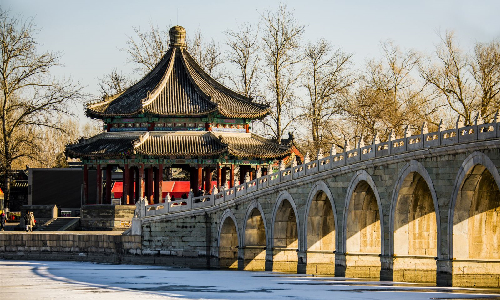
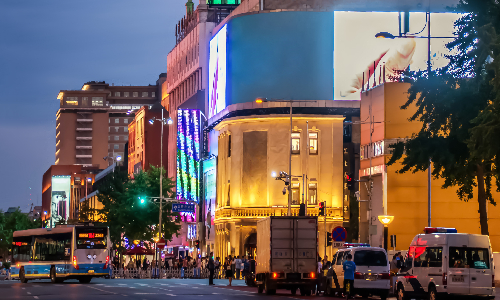
After breakfast, you will go to Tian’anmen Square for sightseeing. Located in the center of Beijing, Tian’anmen Square occupies an area of 440,000 square meters, with 880 meters in length from north to south and 500 meters in width from east to west. It can accommodate 1 million people for grand gatherings. Walking into the square, you can see a pair of marble pillars. One pair is in front of the Tian’anmen Gate Tower and the other pair behind it. Each of the pillars is 9.57 meters high, 98 centimeters in diameter, and 20,000 kilograms in weight. Carved from white marble, the pillars have square bases. There are patterns of dragons and auspicious clouds carved on the pillars. You can take a close look when you visit here.
Then you will come to the Forbidden City (closed each Monday). The Forbidden City is an imperial palace of the 24 emperors in the Ming and Qing Dynasties in China. It is one of the largest and best-preserved ancient wooden-structure palace complexes in the world. Built in 1420, it covers an area of about 720,000 square meters, with a construction area of about 150,000 square meters. Emperor Zhu Di, the third emperor in the Ming Dynasty, ordered craftsmen to build the Forbidden City, and the construction lasted for almost 14 years. During his reign from 1402 to 1424, he made great contributions to the Ming Dynasty. For example, he commanded scholars to compile The Yongle Canon, the world’s earliest and biggest encyclopedia, containing 22,937 volumes and was bound into 11,095 books with a total of 370 million Chinese characters.
After walking through the Forbidden City and going northward, you will visit Jingshan Park. Jingshan Park was a royal garden in the Ming and Qing Dynasties. It was built in 1928, covering an area of 23 hectares including 1,100 square meters of flowers and lawns. Peonies in the Peony Garden are worth seeing. Every May, 20,000 peonies of 200 varieties in the garden will be in full bloom, which is spectacular. The peonies here are famous for their large size, bright color, and long blooming time. If you come at the right time, you can seize the opportunity to enjoy this colorful sea of flowers.
In the afternoon, we will drive northeast for about one hour and fifteen minutes to come to Mutianyu Great Wall, around 68 kilometers away from Jingshan Park. The Great Wall is a marvelous defensive project built by Qin Shihuang, the first emperor of the Qin Dynasty. Mutianyu Great Wall is the best-preserved and longest section in the Great Wall. You will have enough time to go around on the Great Wall and marvel at its magnificence. Don’t forget to take some nice pictures! Then you will be transferred back to your hotel and have a nice rest.
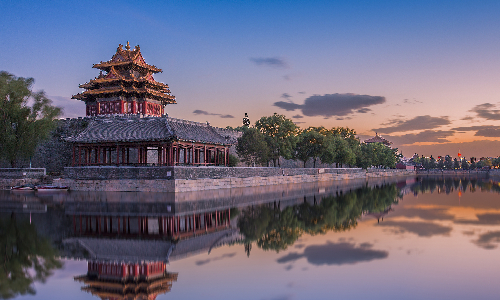
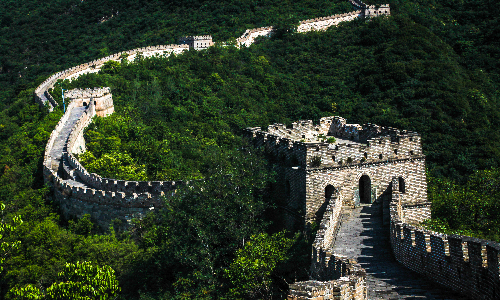
Your 22-day China Panoramic Tour is going to end today. Your guide will send you to the airport according to your flight schedule and say goodbye to you. We hope that you are satisfied with our travel plans and look forward to serving you again in the future!
Author: Gao Yamei
Proofreader: Li Yiwen
| City | Five Star hotel list | Four Star hotel list |
|---|---|---|
| HongKong | Harbour Grand Kowloon | Harbour Plaza North Point Hotel |
| Kunming | Grand Park Kunming | UChoice Hotel |
| Guilin | Lijiang Waterfall Hotel | Guilin Bravo Hotel |
| Yangshuo | Yangshuo Greenlotus Hotel | New Century Hotel |
| Kunming | Grand Park Kunming | UChoice Hotel |
| Lijiang | Wonderport International Hotel | Lijiang Wangfu Hotel |
| Chengdu | Sofitel Chengdu Taihe | Holiday Inn Express Chengdu Jinniu |
| Shanghai | Ocean Hotel Shanghai | Ambassador Hotel |
| Suzhou | Grand Trustel Aster Hotel Suzhou | Suzhou Jasmine Hotel |
| Hangzhou | Landison Plaza Hotel | Best Western Plus Meiyuan Hotel Hangzhou |
| Xi'an | Tianyu Gloria Grand Hotel Xi'an | Sunworld Dynasty Hotel |
| Beijing | Sunworld Dynasty Hotel Beijing Wangfujing | Sunworld Hotel Wangfujing |
 |
![]() About your child or infant, please contact us for a discounted price.
About your child or infant, please contact us for a discounted price.



We started with a few days in Beijing & ended in Shanghai, from where we visited the Forbidden City and Great Wall. In between we visited Terra Cotta Warriors Museum, Panda Base, Shanghai Disneyland.

We had a wonderful holiday in China which will remain long in the memory. China is a breathtakingly beautiful country full of splendid temples and palaces, mountains and rivers, peaceful rural scenes and bustling shopping streets.
 QUICK ENQUIRY
QUICK ENQUIRY